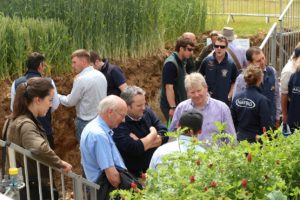 Soil organic matter levels have plummeted in recent years, dramatically affecting the health of soils. Alongside poor soil structure, this is proven to reduce cereal yields by up to 60%, so ensuring measures are in place to rectify such damage has never been more important.
Soil organic matter levels have plummeted in recent years, dramatically affecting the health of soils. Alongside poor soil structure, this is proven to reduce cereal yields by up to 60%, so ensuring measures are in place to rectify such damage has never been more important.
Whether it’s through mechanical practices or crop choice, there are many options for managing soil structure. “Soil is absolutely vital in arable production, so keeping it in best possible health is the foundation of a productive, profitable and viable business,” says Jon Day, event organiser. “At Cereals, we want to give farmers all the information they need to be in the best position to maximise their profits.”
Opico is among many exhibitors at this year’s event launching machinery designed to tackle some of biggest soil compaction issues. Its new He-Va Combi-Lift Pre-Cultivator is designed to subsoil up to 350mm deep and allows soil loosening at the same time as drilling or cultivating
“The He-Va is perfect for a range of tasks and can be lifted out of work when not needed – while still operating the drill or cultivator,” says James Woolway, Opico’s managing director. “This means specific ground can be targeted, such as poorly drained areas of the field or pockets of compaction.”
Giving visitors more than just a chance to view static equipment, Cereals has over 5ha of working demonstrations where exhibitors will put kit to the test. This year’s demos are set to include equipment from Claydon, J Brock & Sons and Mzuri – allowing visitors to directly compare the power and performance of the latest machinery on the market, from no-till drills to subsoilers.
While machinery has often been the first line of defence for farmers tackling structural issues within their soils, a lot of growers are also looking to crops to improve structure and add organic matter.
Allowing visitors to get up close and personal with some of the most common structural issues and compare the rooting benefits of different crops, this year’s Soil Pit will be bigger than ever . At 20m long it will include crops such as winter and spring beans, oats and wheat, as well as cover crops like radish, vetch and radish/oat mixes. In addition, this year’s pit will include a new compaction area to highlight the impact of poor structure on rooting ability.
“By drilling different crops with a variety of sowing dates and digging the soil pit just before the event, we can show farmers what’s really going on beneath the surface,” explains Ron Stobart, head of farming systems research at NIAB. “Cover crops are an increasingly popular option to improve soil condition and reduce erosion.”
A number of crop production specialists will also be on hand sharing research and advice on how growers can get the most from their soils and therefore their cash crops.
Nutrition is clearly an important factor, and nitrogen is the number one choice in the search for higher yields, says Jon Telfer, development manager at Yara. However, there are a number of other factors that can limit crop performance – including soil structure, organic matter, and the interaction of other nutrients.
“Soil fertility is key and, rather than guessing, factors such as soil type and texture as well as biological fertility should be measured,” adds Mr Telfer. “Crops need a variety of nutrients to complete the growing process and a deficiency of any single one is enough to limit yield.”
Tickets are still on sale via the website www.cerealsevent.co.uk/tickets and visitors can use the promocode CEREALS17TOS to save over 15% on tickets.





